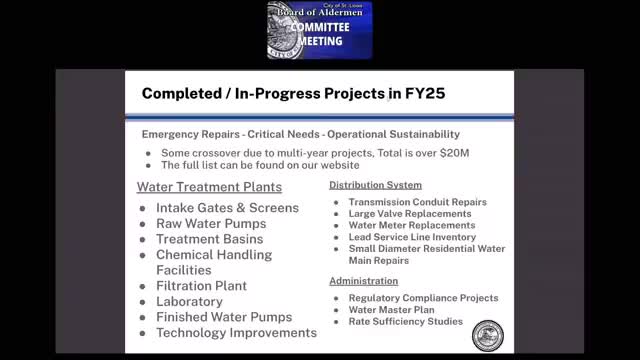Saint Louis Water Division secures $1.3M contract for comprehensive water master plan
June 13, 2025 | St. Louis City, St. Louis County, Missouri
Thanks to Scribe from Workplace AI , all articles about Missouri are free for you to enjoy throughout 2025!

This article was created by AI using a video recording of the meeting. It summarizes the key points discussed, but for full details and context, please refer to the video of the full meeting. Link to Full Meeting
The session began with an update on the water master plan, which has recently secured an executed contract valued at $1,275,000. This comprehensive assessment will evaluate water production, distribution, and business functions over the next year. It aims to forecast demand for the next 20 years and develop a capital renewal plan, which will also consider the impact on water rates.
The committee addressed the necessity of a rate sufficiency study, required by bond indentures, following a rate increase implemented on July 1, 2023. This study will integrate a cost of service analysis, with estimated costs ranging from $75,000 to $150,000. The master plan will inform this study, ensuring a cohesive approach to financial planning.
Additionally, the committee discussed non-priority projects that could enhance efficiency, such as improvements to the lime handling and processing facility. This project, while not classified as a priority, is expected to yield significant savings by automating processes and reducing chemical costs.
Regulatory changes were also a focal point, particularly concerning discharge permits and lead regulations. The city is undertaking a $300,000 study to review water treatment and discharge practices. Efforts to inventory lead service lines are ongoing, with an estimated replacement cost of $400 million for approximately 40,000 lines.
The meeting further addressed the issue of "forever chemicals" (PFAS), noting that current tests show no detection in the city's water supply. The committee emphasized the importance of maintaining rigorous testing protocols and compliance with evolving regulations.
Water main breaks were discussed, revealing a higher-than-average rate of 340 breaks per year, attributed to aging infrastructure. A $5 million project is planned to assess transmission conduits to mitigate this issue.
The committee also reviewed financial challenges, including rising delinquency rates in customer payments, exacerbated by the COVID-19 pandemic. Strategies to address these delinquencies are being developed in collaboration with the mayor's office.
In conclusion, the meeting underscored the city's commitment to enhancing water quality and infrastructure while navigating financial and regulatory challenges. The next steps include advancing the master plan and integrating findings from various studies to ensure sustainable water services for St. Louis residents.
Converted from Public Infrastructure and Utilities Committee - June 11, 2025 meeting on June 13, 2025
Link to Full Meeting
Comments
View full meeting
This article is based on a recent meeting—watch the full video and explore the complete transcript for deeper insights into the discussion.
View full meeting